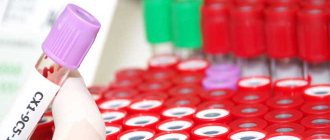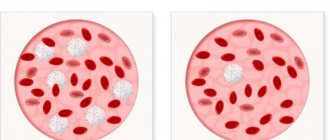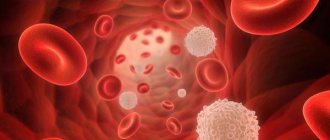Reduced level of lymphocytes - what does this mean?
A low level of lymphocytes in a child’s blood is called “lymphocytopenia.” This phenomenon is observed in children with congenital or acquired immunodeficiency or after acute forms of viral and infectious diseases. Often this disease also affects adults.
A decrease in the level of lymphocytes, although not a dangerous condition, requires specific treatment. Without effective therapy, the patient's body is most susceptible to viral and bacterial diseases. In addition, a person’s illnesses, which have always been in a “dormant” state, become aggravated.
Information! In the International Classification of Disease, this pathology has code D 72.9.
A decrease in the level of lymphocytes can be a signal of the development of dangerous diseases:
- heart or kidney failure;
- acute viral diseases and infections;
- diseases of the gastrointestinal tract;
- autoimmune pathologies;
- human immunodeficiency virus;
- Hodgkin's syndrome;
- intestinal pathologies;
- acute infectious diseases;
- cancer development or metastasis.
About the causes of lymphopenia in children
Congenital lymphopenia is a problem that manifests itself in a child in the first months of his life. As a rule, a baby marked with this syndrome often gets sick and has developmental problems.
Acquired lymphopenia can overtake a person at any time in his life, but most often manifests itself during puberty.
Causes of congenital deficiency of lymphocytes in the blood of a child:
- Wiskott-Aldrich syndrome (otherwise called primary human immunodeficiency);
- problems with stem cell generation caused by bone marrow aplasia;
- tumor processes affecting the thymus or lymph nodes.
Causes of acquired lymphopenia:
- infection of the body with the human immunodeficiency virus (HIV);
- tuberculosis, syphilis and other serious diseases caused by infectious agents entering the body;
- long-term use of potent medications;
- regular and heavy exposure to ultraviolet radiation;
- most autoimmune diseases;
- severe toxic damage to the body (especially in the early years of a child’s life);
- oncohematological diseases;
- undergoing radiation and chemotherapy.
How to deal with a deficiency of lymphocytes in the blood of a child? Children susceptible to this problem should receive adequate and timely treatment, primarily aimed at eliminating the problem causing lymphopenia.
For idiopathic lymphopenia, which has no objective cause, a special operation may be prescribed to transplant stem cells from a healthy donor.
In the vast majority of cases, these operations allow you to get rid of the problem or significantly reduce its manifestations.
Video:
Lymphopenia is a condition that cannot be ignored. However, you should not panic when you receive the results of blood tests, which indicate a reduced number of lymphocytes in the blood.
To confirm or refute the data of the initial analysis, you need to donate blood again. It is best to carry out this procedure in a trusted clinic equipped with a good laboratory.
Deliberately ignoring lymphopenia, as well as refusing to treat the problems that provoke it, can cause the complete destruction of the child’s immunity.
If you want to protect your child from problems and give him a happy childhood, not overshadowed by health problems, then do not ignore even the most minor changes in his well-being.
If any symptoms are detected, even if indirectly indicating the presence of lymphopenia, you should immediately consult a hematologist.
3057
Classification of lymphocytopenia
First of all, lymphocytopenia is classified depending on its origin:
- Absolute. This type of disease is associated with insufficient production of white cells in the blood. This condition is observed in patients with congenital or acquired forms of immunodeficiency, blood cancer, liver pathologies and other serious diseases. Sometimes absolute lymphocytopenia is diagnosed in infants. Unfortunately, in this case the consequence is the death of the child.
- Relative. It is associated with increased levels of neutrophils. As a rule, the causes of this condition are acute forms of viral and infectious diseases.
In addition, a distinction is made between congenital and acquired forms of lymphocytopenia. The first occurs as a result of any congenital diseases or intrauterine infection of the fetus. The second is due to the impact on the child after birth. For example, this condition can be caused by taking medications, poisoning with toxic substances, or viral diseases. There are also chronic and acute stages.
Diagnostics
The number of white cells in the blood can only be determined by conducting a laboratory blood test. Blood sampling is carried out in compliance with the following rules:
- You need to donate blood on an empty stomach;
- one day before the procedure, you must avoid heavy foods, drinks, and medications (the latter must be agreed upon with your doctor);
- the child must be calm during the procedure, as stress can lead to errors in test results.
If it is determined that the number of immune cells in the blood is less than normal, a repeat procedure is prescribed, and if the preliminary diagnosis is confirmed, a comprehensive examination is prescribed.
There is no specific treatment. The tactics of therapeutic measures will depend on the underlying factor. If low lymphocytes in a child are not the result of a pathological process, normalizing the diet and daily routine is sufficient. These same measures can be used as preventative measures.
Norm of lymphocytes in the blood
Normal levels of lymphocytes in the blood vary. They change as a person grows older. Moreover, the older he is, the lower the values. The highest rates can be observed in newborns and children under one year old. In addition, the level of cells also depends on the person’s nutrition and on the time of day at which the blood was taken. For this reason, the study is always carried out at the same time - mainly in the morning.
In order to determine whether the values are increased or decreased, you need to compare two indicators - the percentage of lymphocytes and the absolute number of cells in the blood.
Table of normal lymphocyte values depending on age.
| Child's age | Lymphocyte percentage |
| Up to a year | 45 — 70% |
| From one year to 2 years | 35 — 60% |
| From 2 to 5 years | 30 — 60% |
| From 6 to 9 years | 26 — 55% |
| From 11 to 15 years | 24 — 46% |
| From 16 years old | 20 — 35% |
Information! A high level of lymphocytes at birth also indicates the imperfection of the child’s immune system. As you grow older, it gets stronger, and the number of cells decreases.
Small deviations from normal values do not always indicate the development of an infectious disease. Some people have lower than normal levels of lymphocytes at birth. This continues after adulthood. Therefore, in this case it can be considered a congenital feature. It should be noted that this normal deviation never exceeds 2%. Therefore, to accurately determine the child’s condition, the doctor may prescribe a diagnosis in the form of a general blood test.
What is lymphopenia?
If a blood test reveals that the child’s lymphocytes are greatly reduced, it is necessary to undergo additional examinations to identify the cause of this disorder. This deviation is called lymphopenia in children and indicates disturbances in the functioning of the immune system.
Lymphocytes below normal levels in a child can be observed after infectious diseases. Thus, few lymphocytes in a child’s blood are detected during ARVI and influenza, which indicates a weak immune system due to an infectious disease.
A decrease in lymphocytes in the blood is called lymphopenia
In ICD-10, this violation is designated by code D72.9.
A low level of lymphocytes in a child’s blood may indicate sluggish infectious and inflammatory processes and helps make a diagnosis in the presence of unclear complaints of fatigue, malaise, and general weakness.
Symptoms of a lack of lymphocytes
It is not easy to determine lymphocyte deficiency by eye.
In order to notice pathology in time, the mother needs to carefully monitor the condition of her child. This is due to the fact that only indirect signs can indicate the development of lymphocytopenia. Symptoms of the disease:
- fatigue, lethargy of the child;
- lack of sleep;
- nervousness and aggressiveness;
- pale skin (sometimes it can acquire yellowish tints);
- irritation of mucous membranes;
- rash;
- frequent colds;
- enlarged lymph nodes.
Red blood cells and hemoglobin
— By determining the number of red blood cells, hemoglobin concentration, hematocrit, the presence or absence of anemia or erythrocytosis is established in a person. Each of these conditions can be either an independent disease or a concomitant symptom or complication of certain internal diseases, infectious and oncological pathologies. With anemia, a person copes worse with infections and has a more difficult time undergoing operations.
Why might hemoglobin levels decrease? There are three reasons:
1) violation of the synthesis of red blood cells in the bone marrow;
2) acute or chronic blood loss;
3) eating disorders.
Today, unbalanced nutrition is the main cause of anemia among Belarusians.
Treatment and prevention
Treatment of lymphocytopenia is aimed primarily at treating the disease that caused it. For example, if a decrease in the level of lymphocytes occurred due to taking medications, then the only possible treatment would be to replace the medication. If the lack of cells is a congenital condition, then the patient is prescribed intravenous administration of gamma globulins. Although this method will not eliminate lymphocytopenia, it will significantly reduce the likelihood of developing infectious diseases. If the patient’s diet was low in protein, then he is prescribed a high-protein diet.
How to treat the disorder
There are no special medications that are prescribed for low lymphocytes. For this reason, self-medication is dangerous. Only a doctor should prescribe a course of therapy, and the treatment will be comprehensive. The child will have to take vitamins, possibly medications to eliminate the root cause of lymphopenia, and also eat properly.
You can increase lymphocytes in the following ways:
- walk more in the fresh air, move actively;
- maintain hygiene, wash your hands and do not eat unwashed fruits and vegetables;
- consume foods containing protein.
Traditional recipes:
- Pollen. The preparation is mixed with liquid honey in a ratio of 2:1. You need to take the remedy 1 tsp. Once a day on an empty stomach, drink tea or milk.
- Apples, cranberries and walnuts. Peel 4 apples, cut out the core, pass the fruit, 500 g of berries and 1 cup of nuts through a meat grinder, add 0.5 cups of water and sugar, put the mixture on low heat and bring to a boil. Take the product 1 tbsp. l. daily.
- Fresh juices. Pomegranates, beets, carrots, cranberries and cherries increase the number of lymphocytes in the blood and strengthen the body's defenses. Juices from these vegetables, fruits and berries are recommended to be regularly included in your daily diet. Only juices should be freshly squeezed.
In special cases, immunoglobulin injections and blood transfusions may be prescribed. These procedures can only be performed in a medical facility.
Medicines
If tests show that a child has few lymphocytes, he will most likely be prescribed one of these medications:
- Ascorbic acid. Ball-shaped tablets with a large amount of vitamin C in the composition.
- Vitamin C effervescent tablets. The drug does not contain sugar and is more suitable for young children.
- Ascovit effervescent tablets. It is similar to the previous one, but has different tastes. However, flavoring additives can cause allergies, so the drug is not suitable for everyone.
Important information: What is WBC in a child’s blood test (table of interpretation and norms)
Vitamin C is an essential component in the production of leukocytes, so it must be included in the treatment of leukopenia.
Corrective diet
There is no diet that specifically increases lymphocyte levels. But, as in the case of drug therapy, ascorbic acid must be present in food.
The following foods are considered more fortified:
- cherry;
- bell red pepper;
- parsley;
- rose hip;
- black currant;
- dill;
- Brussels sprouts;
- citruses;
- kiwi;
- onion and garlic.
At the same time, large consumption of citrus fruits can cause allergic reactions, so it is necessary to include in the child’s diet those foods that his body tolerates well.
Complications
If the level of lymphocytes is low for a long time, and treatment does not bring any effect, lymphocytopenia can lead to complications in the form of other dangerous diseases and conditions.
Among them:
- weakened immunity and, as a result, frequent acute respiratory diseases and acute respiratory viral diseases;
- development of malignant tumors;
- acquired immunodeficiency syndrome.
Despite the fact that a low level of lymphocytes is not an acute or fatal disease, it is recommended to consult a doctor when the first signs appear. Lymphocytopenia can be a signal of the development of a dangerous disease. In the best case, it will simply be a lack of protein, and in the worst case, AIDS or oncology. Be healthy!
Why is lymphopenia dangerous?
Having discovered that lymphocytes in a child’s blood are low, treatment cannot be put on hold. It is necessary to undergo a comprehensive examination to identify the cause of this pathology.
A low level of lymphocytes in a child's blood may indicate dangerous diseases such as cancer and HIV.
In addition, lymphopenia is provoked by the presence of hidden foci of infection in the body. This leads to a decrease in immunity, as a result of which episodes of colds and ARVI become more frequent. Timely detection of lymphopenia and treatment of its cause will normalize the immune system and strengthen the baby’s health.











